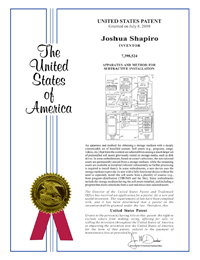
What it is
How it works
Why it's better
How it's used
Who would use it
Calling Michael Dell
Calling Steve Jobs
Who will win
Why it's timely
Green credentials
How much would it cost
Frequently Asked Questions
Give me the details
And there's more
Patents pending
To learn more |

|
Sideloading refers to methods of creating unique distributions of software from a common base that have the following characteristics:
- • The software can be any form of digital media, for example programs, audio files, video files, text files, games, ring tones, or data.
- • The methods work on any new digital device - computers, cell phones, game consoles, music players, televisions, even picture frames.
- • The methods can be practiced in a factory, store, office, or home setting.
- • The methods protect the digital media from unauthorized access.
- • The common base can be arbitrarily large.
- • The number of unique distributions is arbitrarily large.
- • The number of items in each distribution is completely variable.
• The variability depends on customer choice subsequent to the creation of the common base.
Personal computers for the mass market (e.g., Dell or HP) are necessarily general-purpose machines. Each purchaser of such a general-purpose machine has the option to customize the machine to her specifications. Thus, we might think of a single personal computer order as an n-tuple (n= h+s) of choices {x1,x2,….,xh,xh+1,…xn} where each xi represents a choice the buyer can make.
The first h choices are choices are hardware choices that actually involve physical change to the machine. The last s choices are choices of soft assets, all of which affect the disk image that is shipped. If we assume that each of these s choices allows for a binary yes/no decision (as in, do you want this software installed or not), then there are 2s possible configurations and so that many possible disk images must be available.
Typically manufacturers deal with this by limiting choice, keeping s small so that few disk images need be stored. However, this limits their flexibility in designing custom versions of general-purpose machines. As a result, a purchaser is left with the complex task of finding and purchasing additional needed software and installing it herself.
This is an unfortunate situation as the process of installing the new pieces of software is energy inefficient and may cause some already-installed or existing software to fail. Also, it is uneconomical since the aggregate cost to the consumer of separately purchased items is usually higher.
This invention provides an alternative solution that, rather than maintaining an exponential number of disk images, uses a single disk image that supports massively unique customization, if the tailoring of the software is done in reverse. That is, the master disk image initially contains everything the user could possibly have wanted and then the customization involves quickly removing programs that the consumer has not purchased.
This approach works because the added space needed to store all of the programs on offer is available because of greatly increased disk capacities currently available The growth rate of low cost of disk capacity far outstrips the Moore’s law price/performance rate for semiconductors. Difficulties that can arise from removing software can be circumvented more easily than those that arise from adding software.
Furthermore, after removal, the disk space that was used is reclaimed so that the user is left with a disk image that is equivalent to what would have appeared had access to 2s unique configurations been possible. Because erasure need not access the actual data content, but only the directory’s references to that data, similar data storage removal is faster than writing the equivalent data to storage.
|